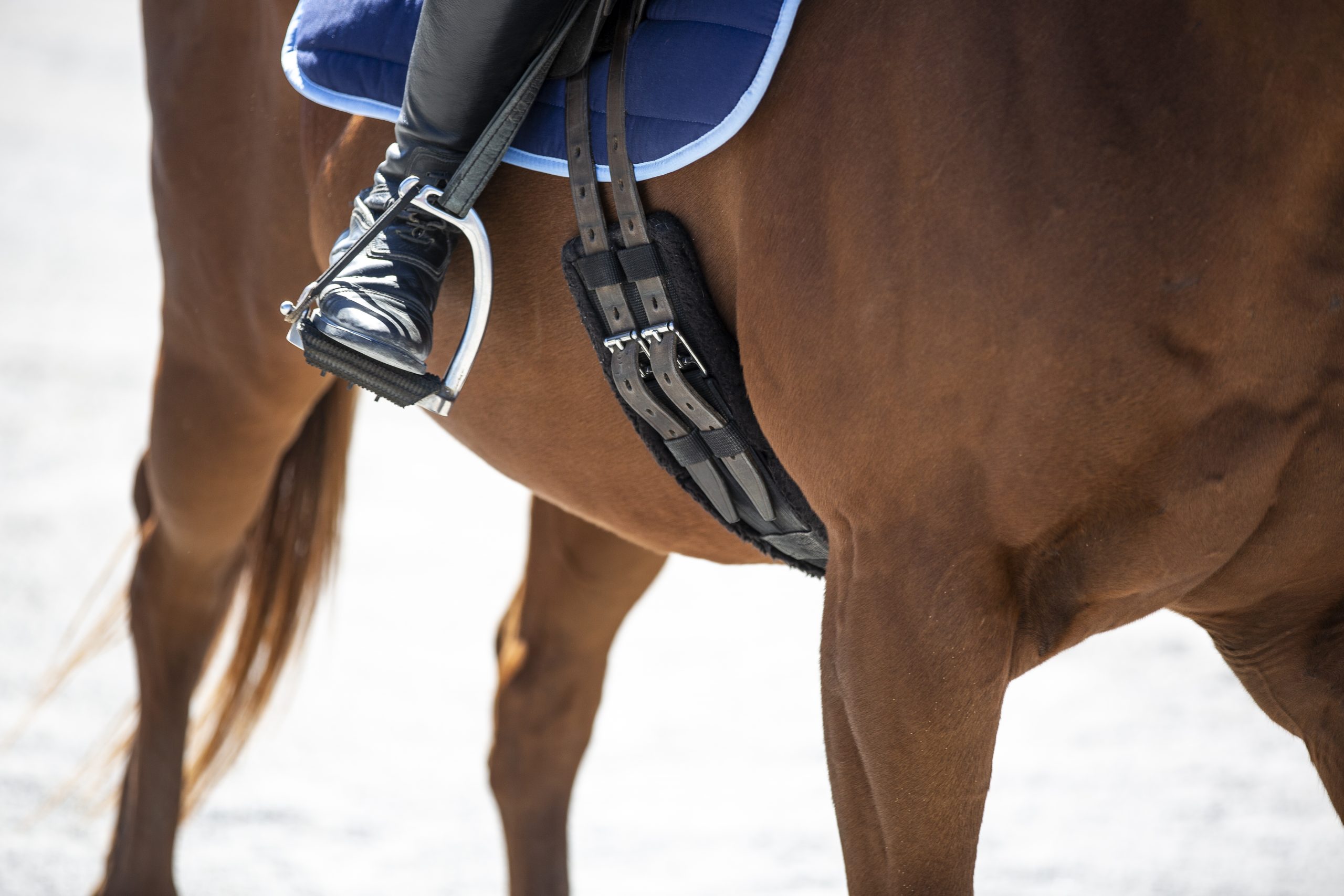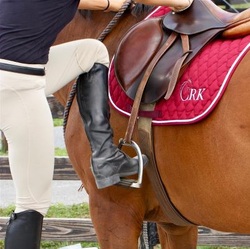Most riders, especially those who do any kind of arena work, are familiar with the concept that a horse should “move off your leg.” This simply means that the horse easily moves laterally away from leg pressure instead of leaning into the pressure or darting forward. A horse that easily moves off leg is a pleasure to ride and is typically more balanced and goes straighter and lighter around turns. In my experience, a lot of people seem to just expect that horses understand this, or will just pick it up if you just keep pushing. I have found that by breaking down the leg pressure cues and teaching the horse what they actually mean, you will have a much lighter, quicker response to your leg cues.
A good example of this is a horse that is difficult in picking up a canter lead. Most riders use outside leg back as a canter cue, but if your horse does not actually understand that outside leg back means move haunches in, the cue does not actually accomplish much. Another example – we typically put on our inside leg to keep our horses from falling in on a turn, but if the horse does not really know to move away from that inside leg, then your cue will not mean too much, and the horse will likely become heavier and take more and more leg to move because he has learned to just accept your leg pressure being there.
So how do we go about training for a lighter horse? Start on the ground using your hand where your leg would be to ask the horse to step over with first his hips, then his shoulders. Do this from both sides. Next ask for the same movements from the saddle. When your horse can consistently move his hips and shoulders independently when you ask then you can begin asking for a small leg yield on a circle. Walk a 10 meter circle, half halt, then ask your horse to step under with his inside hind leg. Just be happy with one or two steps to begin and build on it. You can also practice the sidepass by halting, then asking for hips, shoulders, hips, shoulders until your horse takes a step over with both front and hind legs. Build a solid foundation for your lateral work by starting slow and building in speed, impulsion, and number of steps. Whether you are looking to do canter half passes or just want to keep your horse on the rail around the turns, making sure he understands what your leg pressure means is the beginning! If there is enough interest, I would be happy to make a short video tutorial to demonstrate these exercise, so leave a comment if you are interested, thanks!














14 Responses
Hi Callie! Love this post.
I would really love to work with my horse on leg pressure. I appreciate your thorough instructions, but a video would be a great way to see how it is done by a professional. I was told that pressure on their side to get them to move does not work, as they would lean into the pressure, but a constant tapping would work better due to it being irritating to them. Tapping does not resemble what leg pressure would be………….I’M CONFUSED! Please help!
Hi Fran, Thanks for the feedback! Tapping, or rythmic pressure, does work better to teach a horse to move away, but after the horse understands what is expected, then a steady but very light pressure can serve as the “cue” for the movement. Does this make sense?
Hi Callie!
I’m in! I’d love to see a video representing what you’ve just described as far as using leg pressure, particularly if you are able to explain the types of pressure you are using and where as you apply them! Looking forward to seeing you in motion!
Corrie
Hi Corrie, Thanks for the suggestion!
As someone who has ridden off and on for years, I’m still not confident I understand leg pressure. I’ve been on lesson horses and squeezed with my legs until they were shaking, I’ve been told in the past to kick with my heels, to grip with my thighs and leave my lower leg completely off the horses side; to “bump bump” – not all at once of course. So I’m never sure how much pressure is the right or reasonable amount, and how often I need to apply it, or if I’m supposed to be applying some degree of pressure all the time. One instructor had me alternate! I love how you ride so I would be grateful to hear your tips and thoughts on this subject in a video.
Hi Natalie,
This is a great suggestion for a video, so I will probably create one and post it for you in the next few weeks. There are a lot of different opinions out there regarding use of the leg. As far as position your leg should hang soft and feel “wrapped” around the horse’s side. You want to have a flexible ankle with the weight on the ball of your foot on the stirrup.
What leg pressure boils down to is that it needs to be able to be consistent. You want to feel as though you can put the leg pressure on, increase it and keep it constant, then release it. I use my leg in this manner – light squeeze, harder squeeze, bump, bump, until I get the response I am looking for. If the horse needs so much leg that I feel I can’t keep it consistent I will use a long crop or whip to tap so the pressure does remain constant.
Try riding without your stirrups and feel how you “naturally” use your legs – this will often give you a much better feeling of how your legs should hang and how they should feel when you apply leg pressure.
Hope this helps!
Since I learn visually, it would be great to see a video. Perhaps one is available on Riding Journals? I’ve never taught any of my horses to yield to leg pressure laterally. Keeping them on the rail when I ride is very difficult. From the article, I might be able to help them learn, but a video would be great. Thanks for all the free tips, Callie.
Hi Miche, are you in Training Journals? If so, take a look at Thunder’s videos – I think he is a good representation of a horse who had trouble staying on the rail and you can watch how I started getting him moving off leg.
I too would be very interested in seeing what you have explained above. Leg yield is a new thing for me; outside leg back to initiate the canter is all I know and It doesn’t really work. I have young horse and although he’s received a little training, I’m sure I’m doing the wrong thing. Seeing it would be a big help. From the ground and then on horsback.
I’ve just discovered you and am enjoying your blog and learing.
Thank you!
Margaret
Hi Callie:
I just recently leased a Percheron 9 year old horse (gentle giant) and have not ridden for 30 years. I am watching your videos on balance and am going to try them next time I am on Thor. I would love a video of the “leg” use. I had a horse who went off my leg pressure when I was younger. Janelle would move away from pressure. So if I put pressure on with my right calf, she would move left, and vice versa. I find that Thor and I are confusing each other. I discovered if I put pressure on with my calf he will almost pivot around my calf, hind end moving away but the rest of him moving around my leg. Which way is right?? I, personally, prefer them moving away from pressure, but may be doing this wrong.
Hi Joy, I am not sure I am picturing the movement Thor is doing correctly, but I also teach moving away from leg pressure. However, if Thor is moving responsively off your leg, he has likely been reinforced for this movement from this leg position, whether it was conscious or accidental. Getting the movement you want from him will mean re-training the response you expect from your leg cue. If you go to my facebook page under videos there is a short clip there of using the fence to help teach moving away from leg pressure. There is no instruction on this specific video, just meant as a visual.
Thank you Callie.
Hi Callie
Thanks for your fantastic videos. I came across this page by accident and would really like a video. I am struggling with the lateral moves and don’t know how to get my horse to move his hips. Been told they were 3 leg positions but I must be giving the wrong cues because my horse moves very stiffly. He doesn’t feel comfortable and I don”t know how to help it. Thanks for all your posts. They are truly fantastic
I would love to see a video of this, particularly how it would look to give the reward for leg yields when you’ve moved to the saddle. Thanks!